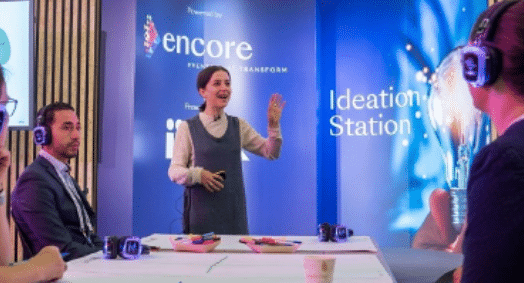Planning events in the future isn’t just about following trends — it’s about understanding them. We’ve been watching the industry and have some tips to help you find the best new ideas for your event planning.
Our industry is going to change a lot in 2025. This will impact how we think about, plan, and run events. You’re not alone in this journey. We’re here to support you every step of the way.
Let’s explore the key trends that impact event planning and how to leverage them to your advantage.
Do more with less

Want to maximize event impact without blowing your budget? You’re not alone. Respondents to our Encore Planner Pulse survey said managing budget constraints is the top priority for 2025, followed by bringing unique experiences or creating a ‘wow’ factor.
Part of what’s driving this trend is that event budgets are expected to rise by no more than 11 percent, but event costs are predicted to increase by 12 percent, per the Northstar Industry PULSE Survey.
We understand the pressure you’re under to create meaningful and engaging experiences, and we’re here to help you find the best solutions. Let’s explore some effective ways to do more with less.
- Meet in second-tier cities. First-tier cities, like New York and Chicago, might have value dates, but second-tier cities offer year-round savings. Plus, they may be more appreciative of your business and willing to offer special perks in exchange for your business.
- Work with convention and visitor bureaus (CVBs). CVBs don’t charge planners for their services. They can do everything from arranging site visits and offering venue advice to suggesting local speakers, supplying volunteer staff and connecting you to local nonprofits for community service initiatives.
- Work with your event technology partner to develop solutions that fit your goals and your budget. Bring your partner in early to your planning process to help optimize your event plan.
Use AI to make things easier

Imagine having a dedicated assistant who takes care of the mundane tasks, allowing you to focus on what truly matters. That’s the magic of using AI.
According to BCD, AI and automation will greatly impact the industry this year. Generative AI tools, such as ChatGPT, Gemini and the event industry-specific Spark, can perform repetitive, time-consuming tasks in seconds, freeing you up to focus on what matters.
You can use AI as:
- A simultaneous translator of event content to make meetings more inclusive.
- A real-time transcriber of event content to make meetings more accessible with closed-captioning.
- A strategic consultant to analyze reams of historical event data and attendee feedback surveys and deliver key insights and actionable next steps.
Get serious about sustainability
![]()
Did you know sustainability initiatives can save you money? That’s why sustainability is becoming a top priority for planners in 2025. According to PCMA’s Meetings Market Survey, 60 percent of planners include sustainability requirements in their RFPs.
Many resources are available now, like LED lighting, signage and LEED-certified venues, making it easier to make eco-friendly choices. Looking to produce more sustainable meetings while being more fiscally responsible?
- Reduce waste. Overflowing buffets and endless food stations generate food waste. And how many more bags, lanyards and water bottles do your participants need? Reduction is an often overlooked — but incredibly effective — strategy.
- Plan vegan/vegetarian meals. Meatless meals are a budget-friendly way to care for participant health and the planet.
- Make sustainable substitutions. Focus on what can be reused or repurposed versus being thrown away. For example, think LEDs instead of traditional lighting, LED walls instead of single-use scenic décor, falcon board instead of foam core, modular trade show booths and digital signage instead of disposable options.
- Think local. Look for ways to leverage and benefit the local host community while enhancing the experience for your guests. For example, hire local vendors, buy local supplies and spotlight local food and entertainment to reduce shipping costs and your carbon footprint.
- Minimize transportation. Look for walkable destinations or venues connected by public transportation options. If shuttles must be used, institute a no-idling policy to preserve air quality.
Where will this year take you?
By embracing these trends — from innovative budgeting, creative agility and AI integration to getting serious about sustainability — you’ll be well-positioned to deliver exceptional experiences that resonate with your participants and set new industry standards.
Together, we can set new standards of excellence in the industry with every event we create. Ready to get started?
When it’s time to select your venue, a site visit is one of the most critical steps. Not only do you get to physically step in your space and imagine your event coming to life, it’s a chance to ask the most important questions with your potential venue team.
Unfortunately, so many of us are busy with the details of the space contracts and food and beverage minimums, that our time with AV providers is often cut short. On your next site visit, be sure to squeeze in some time with your AV partner and ask these questions to ensure a successful event.
What would you recommend to make a greater impact with my budget?
If you only ask one question, this is it. As planners, of course we have ideas right out the gate with an inspiration board – but no one knows the space better than an on-site event experience team. During your site visit, discuss your vision and ask what they would do to make it work within your plan and budget.
Because they have worked so many events within the very space you’re standing in, they can take the groundwork of your initial plan and elevate it – whether it’s rigging screens differently for new vantage points or trying new seating levels. This discussion can change the whole direction of your event and catapult it to new heights.
What other services do you offer?
These days, AV companies do so much more than just audio-visual. With teleconferencing, content design, and event internet, the same company will likely be able to provide you with almost everything you need for your event. So, before you start the taxing process of looking around for extra technology quotes, be sure to explore the opportunity of leveraging your in-house partner.
Are there any exciting new technologies I can employ?
It’s the old adage of “if you don’t ask, you don’t know.” Technology changes rapidly, and there may be something new on the horizon offered by your event partner. Maybe it’s a new mobile engagement app that could be a great way to show meeting value to your stakeholders. Your provider will be eager to talk to you about everything they have – you just have to ask!
Who will be my point of contact, and how hands-on will they be?
Don’t wait until you’ve already signed a contract to ask this question (or worse, until there’s a day-of crisis). Ask up-front how big their team is, and who will handle which parts of your meeting. It’s also a good idea to find out if the entire team will be on-site, or if there is an off-site team (for example, in the case of internet), so you know exactly what you’re dealing with going into your meeting and who’s on first.
What information do you need from me?
Communication is a two-way street, and your event partner may have some questions for you as well that will spark some ideas. Be sure to open up the conversation and make sure they have a full understanding of what you’re trying to accomplish up-front to avoid complications later on.
Takeaways
Arming yourself with these questions for your event partner during your site visit can instill confidence in your decision with venue selection, and ensure a seamless event from the start with a team that understands your goals.
























